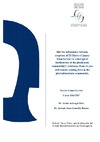Please use this identifier to cite or link to this item:
https://accedacris.ulpgc.es/jspui/handle/10553/74800
| Title: | Did the submarine volcanic eruption of El Hierro (Canary Islands) lead to a biological fertilization of the planktonic community? : evidences from "in situ" and remote sensing data in the phytoplanktonic community | Authors: | Gómez Letona, Markel | Director: | Arístegui Ruiz, Javier González Ramos, Antonio Juan |
UNESCO Clasification: | 251001 Oceanografía biológica 250616 Teledetección (Geología) |
Keywords: | Submarine eruption Fertilization Picophytoplankton Bacterioplankton Chl-a |
Issue Date: | 2017 | Abstract: | The eruption of a submarine volcano south of El Hierro (Canary Islands) in October 2011 led to major physical-chemical changes in the environment. Significant amounts of iron and inorganic nutrients were introduced to the water column from the oxidation of reduced chemical species expelled during the eruptive phase. It has been stated that the environmental fertilization with these compounds enabled the rapid restoration of the ecosystem once the volcanic activity ceased, although no biological evidence for this has been provided yet. To test the biological fertilization hypothesis on the pelagic ecosystem, we studied the evolution and variability in chlorophyll a (from in situ and remote sensing data) combined with information on phytoplankton and bacteria community structure (derived from Flow Cytometry) during and after the eruptive episode (from November 2011 to March 2014). Remote sensing and in situ data revealed that no algal bloom took place neither during nor after the eruptive episode. High satellite chl-a values registered during the eruptive phase corresponded to decoloured waters caused by sulphur compounds expelled by the volcano. In situ measurements of chl-a were low, in the range of the natural annual variability reported in the literature, with no significant differences between stations affected by the volcano and stations on the far field. Spatial and temporal variability in picophytoplankton (Picoeukaryotes, and Synechococcus and Prochlorococcus cyanobacteria), the most abundant size-fraction of the phytoplankton community, didn’t show any response to the volcanic emissions. Only the high nucleic acid (HNA)-content bacteria (the most active groups) exhibited significantly high abundances during the most intense eruptive phase, but values were restored after the eruption ceased. Overall, our results show that the impact of the eruption on the phytoplankton community was not significant, without any evidence of biological fertilization on the pelagic ecosystem, probably due to an efficient renewal of surface waters in the region due to local currents. Temporal changes in chl-a close to the volcano area were caused by seasonal variability in the region, as well as to interannual variability associated with changes in the North Atlantic Oscillation (NAO) phases. | Department: | Departamento de Biología | Faculty: | Facultad de Ciencias del Mar | Institute: | IU de Oceanografía y Cambio Global | Degree: | Máster Universitario en Oceanografía por la Universidad de Cádiz, la Universidad de Las Palmas de Gran Canaria y la Universidad de Vigo | URI: | https://accedacris.ulpgc.es/handle/10553/74800 |
| Appears in Collections: | Trabajo final de máster |
En el caso de que no encuentre el documento puede ser debido a que el centro o las/os autoras/es no autorizan su publicación. Si tiene verdadero interés en el contenido del mismo, puede dirigirse al director/a o directores/as del trabajo cuyos datos encontrará más arriba.
Show full item recordPage view(s)
206
checked on Dec 14, 2024
Download(s)
138
checked on Dec 14, 2024
Google ScholarTM
Check
Share
Export metadata
Items in accedaCRIS are protected by copyright, with all rights reserved, unless otherwise indicated.
